ABSTRACT
Objective. To examine the homicide trends among young people (10–24 years), adolescents (10–19 years), and young adults (20–24 years) in 33 countries in the Americas between 2000 and 2019, with a focus on inequalities between countries in the burden of homicides. Methods. An ecological study was performed using estimated deaths from 33 countries. Age-adjusted rates, percentage change (PC), average annual percentage change (AAPC), and relative risk (RR) were estimated; besides, analysis on social inequalities was performed. Results. In the Americas between 2000 and 2019, homicide has been the leading cause of death with 54 515 deaths on average each year and an age-adjusted rate of 23.6 per 100 000 among young people. The highest rate was found in the Andean subregion (41.1 per 100 000 young people), which also produced the highest decrease (PC = –37.1% and AAPC = –2.4%) in the study period. The risk of homicide in young men is 8.1 times the risk in young women, and the risk in young adults is 2.5 times the risk in adolescents. The three countries with highest risk of homicide for young people are Venezuela (relative risk [RR] = 35.1), El Salvador (RR = 28.1), and Colombia (RR = 26.7). The estimated excess mortality was 26.8 homicides per 100 000 in the poorest 20% of countries compared to the richest 20% of countries in the period 2000–2009, and it decreased to 13.9 in the period 2010–2019. Conclusions. The results of this study add to the knowledge of homicide among young people and can be used to inform policy and programming in countries. Given the great burden of homicide on young people in the region, it is critical that prevention opportunities are maximized, beginning early in life.
|

